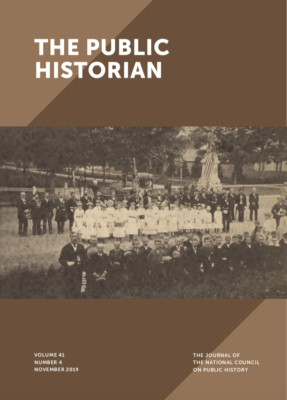Editor’s Corner: Performances
10 December 2019 – James F. Brooks
Editor’s note: We publish The Public Historian editor James F. Brooks’s introduction to the November 2019 issue of The Public Historian here. The entire issue is available online to National Council on Public History members and to others with subscription access.
Performance is always heralded by a risk taking. That is why it is different from practice. A performance is before somebody. We always know in a performance how we have done.
~Greg Dening, Performances, 1995

The dedication ceremony for the memorial to the Union soldiers, Cortland, New York, May 30, 1877. (Photo courtesy of the Cortland County Historical Society)
These cautionary words from the late anthropologist Greg Dening came to me as I reread this issue’s contents. Each of our five essays feature, in a variety of modes, the “performance” of particular historical narratives and the shifting, historically contingent reception they receive from their audiences. History as performance, says Dening, always embodies the double entendre of the past as “knowledge made dramaturgical,” yet also as “metonymy of the present.” What in one moment may be celebratory will, in another, feel discriminatory. Engaging in public historical work, then, is to take risks under the spotlights and to know, for better or worse, how we have done.
Andrea L. Smith argues that upstate New York’s 1929 “Pageant of Decision,” ostensibly staged to celebrate the 150th anniversary of General John Sullivan’s 1779 campaign in the War for Independence, performed New Yorkers’ anxiety about the “Iroquois Revival” that called into question the validity of settler land titles in the region. Even as local white citizens adopted Indian “costumes” and “dances,” the performance reminded the audience of a transformation of the region from “Red” to “White” space, made manifest in the underlying “logic of elimination.” Native peoples were, however unfortunately in the sentiments of colonial nostalgia, rendered absent by the violence and destruction of the American Revolution.
Malgorzata Rymsza-Pawlowska asks us to consider unexplored associations between the rise of living history museums in the 1960s and ’70s and the concurrent explosion of the “hippie” counterculture. This hits a little close to home for me—in 1978 I served on a crew (whose ponytails, bell bottoms, and tie-dies signaled our affinity for hippiedom, if also historic preservation) that dismantled a 1690 timber frame house in Farmington, Connecticut, endangered by new highway construction, and relocated it. Rymsza-Pawlowska traces how Plimoth Plantation underwent dramatic recasting across the late 1960s and 1970s, and points out that Plimoth and scores of hippie communes throughout North American hewed to shared ideals: an ethos of self-sufficiency, “living off the land,” authenticity, anti-capitalism, communitarianism, and home crafting. These shared ideals, Rymsza-Pawlowska argues, are more than contemporaneous; in her view, the counterculture helped shape the practice of living history.
In Louisville, Kentucky, Joy Giguere follows the aftermath of Mayor Greg Fischer’s 2016 decision to remove a Confederate monument erected in 1895. More than two dozen major cities have now joined Louisville, and in each a counter-performance from disaffected citizens has unfolded as a “defense of history.” Giguere’s essay historicizes the defense of monuments itself, as the putative Union state of Kentucky came quickly to embrace and perform Lost Cause nostalgia. Only after the integration of city schools and the University of Louisville in the 1960s did a counter-narrative emerge, with the first call for removal coming in 1989. Twenty-seven years later, the monument was finally removed from Louisville but not from public view—it now resides in the majority-white town of Brandenburg.
Evan Faulkenbury extends our examination of the evolving historical significance performed by Civil War monuments in the case of the Cortland, New York, Union Soldier Monument. Erected in 1876 to mark the sacrifice of the 310 young men who marched south for the Union cause and never returned, it also served to obscure “the Civil War’s larger meanings beneath a veil of sentimentality and romance.” The decades ahead saw the statue’s performance align with national interests—westward settlement, national consolidation, and white masculinity as the default symbol of nationhood. By 2013, as the town designed a new stage for musicians in Courthouse Park, it stood in the way of downtown revitalization. Yet some citizens rallied to its defense, and there unfolded a community-wide debate about meanings, past and present. The monument continued to provoke consideration of historical meaning and myth-making.
Finally, Juliet Larkin Gilmore and Kristina Lee walk us through a community-based performance to preserve the remains of Fort Negley, built in 1862 in the wake of Nashville’s surrender to the Union Army, and a central symbol for the humiliating defeat of CSA General Johnston in December 1864. During the war, free black settlements surrounded the masonry fortifications on the hilltop, and during Reconstruction evolved into neighborhoods of freemen and women. By the 1900s, however, it had become a theatrical space for KKK rallies, replete with night riders and cross-burnings. A planned condominium development would have masked its many meanings, and staff, faculty, and students at Vanderbilt University formed a digital archive called the Fort Negley Descendants Project (FNDP) to support the anti-development community. By drawing public attention to the site, the FNDP forced developers to abandon the project. More important, however, is how Fort Negley now serves to energize the partnership between the university and community descendants in continuing oral history collections, site interpretation, and walking tours.
We at the journal feel this array of public history “performance pieces” reflect the particular manners in which the discipline puts the past in conversation with the present.



